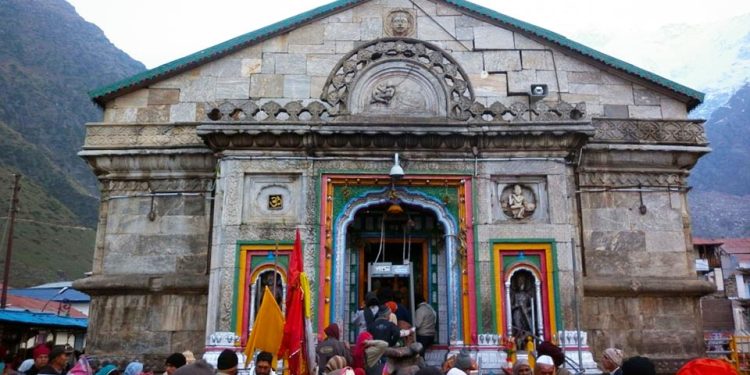Kedarnath Templeis aHindu templededicated to BhagwanShiva. It is in the GarhwalHimalayan rangenear theMandakini riverinKedarnath,UttarakhandinIndia. Due to extreme weather conditions, the temple is open only between the end of April toKartik Purnima. During the winters, the viagra has from Kedarnath temple are brought toUkhimathand worshipped there for six months. LordShivais worshipped as Kedarnath, the ‘Lord of Kedar Khand’, the historical name of the region.
Shrine’s History
According to History, during the Mahabharatha war, the Pandavas killed their relatives; to absolve themselves of this sin, the Pandavas undertook a pilgrimage. But Lord Vishweshwara was away in Kailasa in the Himalayas. On learning this, the Pandavas left Kashi. They reached the Himalayas via Haridwar. They saw Lord Shankara from a distance. But Lord Shankara hid from them. Then Dharmaraj said: “Oh, Lord, You have hidden from our sight because we have sinned. But, we will seek You out somehow. Only after we take your Darshan would our sins be washed away.
This place, where You have hidden will be known as Guptakashi and become a famous shrine.” From Guptakashi (Rudraprayag), the Pandavas went ahead till they reached Gaurikund in the Himalayas valleys. They wandered there in search of Lord Shankara. While doing so Nakul and Sahadev found a buffalo which was unique to look at. Then Bheema went after the buffalo with his mace. The buffalo was clever and Bheema could not catch him. But Bheema managed to hit the buffalo with his mace. The buffalo had its face hidden in a crevice in the earth. Bheema started to pull it by its tail. In this tug-of-war, the face of the buffalo went straight to Nepal, leaving its hind part in Kedar. The face isDoleshwar Mahadev in Sipadol, Bhaktapur, Nepal. On this hand part of Mahesha, a JyotirLinga appeared and Lord Shankara appeared from this light. By getting a Darshan of Lord Shankar, the Pandavas were absolved of their sins.
The Lord told the Pandavas, “From now on, I will remain here as a triangular shaped JyotirLinga. By taking a Darshan of Kedarnath, devotees would attain piety”. A triangular shaped rock is worshipped in Garbhagriha of the temple. Surrounding Kedarnath, there are many symbols of the Pandavas. Raja Pandu died at Pandukeshwar. The tribals here perform a dance called “Pandav Nritya”. The mountain top where the Pandavas went to Swarga, is known as “Swargarohini”, which is located off Badrinath. When Darmaraja was leaving for Swarga, one of his fingers fell on the earth. At that place, Dharmaraj installed a Shiva Linga, which is the size of the thumb. To gain Mashisharupa, Shankara and Bheema fought with maces. Bheema was struck with remorse.
He started to massage Lord Shankaras body with ghee. In memory of this event, even today, this triangular Shiva JyotirLinga is massaged with ghee. Water and Bel leaves are used for worship. When Nara-Narayan went to Badrika village and started the worship of Parthiva, Shiva appeared before them. Nara-Narayan wished that, for the welfare of the humanity, Shiva should remain there in his original form. Granting their wish, in the snow-clad Himalayas, in a place called Kedar, Mahesha himself stayed there as a Jyoti. Here, He is known as Kedareshwara.

Legends Associated with This Shrine
The legend goes that Nara and Narayana – two incarnations of Vishnu performed severe penance in Badrikashraya of Bharat Khand, in front of a Shivalingam fashioned out of the earth. Pleased with their devotion, Lord Shiva appeared in front of them and said that they may ask for a boon. Nar and Narayan requested Shiva to take up a permanent abode as a Jyotirlingam at Kedarnath so that all people who worship Shiva shall be freed from their miseries.
According to yet another popular legend related to Kedar Temple, Goddess Parvati worshipped Kedareshwar to unite with Shiva as Ardhanareeswarar. Besides, the Pandavas are believed to have visited this area several times. Arjuna is believed to have come here to pray to Shiva to obtain the coveted Pasupataastra. The other Pandavas are believed to have come here in search of him, where Draupadi came across the heavenly lotus Kalyana Saugandikam and requested Bhima to bring here some more of the same. It was during his venturing out to seek these flowers that Bhima met Hanuman.
Architectural Relevance of This Shrine
Kedarnath Shrine is scenically placed amidst the lofty, snow – covered mountains and grassy meadows covering the valleys. Immediately behind the temple is the high Kedar dome peak, which can be sighted from great distances. It is believed that the temple of Kedarnath was constructed by the Pandavas. At the entrance of the temple is the statue of Nandi, the divine bull of Shiva. Walls inside the temple are exquisitely carved with images. The revered Shiva Lingam housed in the temple is in the unusual pyramidal form.
Shrine’s Map Location and How to Go There
By Road
Well connected to Rishikesh, Haridwar, Dehradun and Delhi.
By Rail
Nearest railhead is at Rishikesh, 243 km.
By Air
The nearest airport is Jolly Grant, 260km.
Shrine Timings
The temple at Kedarnath enshrining the Jyotirlingam of Shiva opens only 6 months a year (April-November) when the sun enters the zodiac sign of Aries and it is closed when the sun enters Scorpio. The priests then go to Ukhimath, where the worship of Kedareshwara is continued during the winter season.
Extra Information About this Shrine
Best Time to visit:- The ideal time or peak season to go for a Char Dham Yatra is from May to October, except monsoons. This is because; all the four sacred sites are perched in Garhwal Himalayas, which is prone to heavy snowfall. As a result, all the passage leading to the shrines are blocked. Moreover, during the monsoon season, there is undue threat of having landslides, which can further disrupt the journey.













































